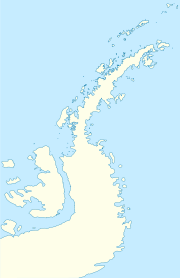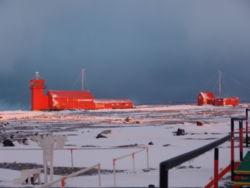- Marambio Base
-
Marambio Base — Antarctic base — Location of Marambio Base within the Antarctic Peninsula Coordinates: 64°14′27.65″S 56°37′36.31″W / 64.2410139°S 56.6267528°WCoordinates: 64°14′27.65″S 56°37′36.31″W / 64.2410139°S 56.6267528°W Country  Argentina
ArgentinaProvince Tierra del Fuego Province Department Antártida Argentina Elevation 5 m (16 ft) Population – Total 150-55 Time zone ART (UTC-3) Base Antártica Marambio is the main Argentine base in Antarctica, and it is located in Seymour-Marambio Island, some 100 km (88 mi) from the more coastal and smaller Esperanza Base. It was the first airfield in Antarctica and is still one of the most frequently used ones due to the suitability of its airfield for wheeled landing.[1]
This permanent base, founded on October 29, 1969, was named after Argentine Air Force pilot Vice-Commodore Gustavo Argentino Marambio, one of the first pilots flying over Antarctica.
IATA: none – ICAO: SAWB Summary Airport type landing track Serves Marambio Base Location South Pole, Antarctica Runways Direction Length Surface ft m 05/23 4,134 1,260 Graded[2] Prior to the base's foundation a team led by Vice-Commodore Mario Luis Olezza built the 1200 m (3800 ft) long, 40 m (120 ft) wide landing track, the first one in the continent. Nowadays, the track, oriented 05/23, is equipped with VOR, DME and NDB electronic landing systems. It also has a radio beacon, electronic and flashing beacons. Supplies are taken to Marambio Base during the whole year, to be later distributed to other Argentine bases nearby (except for Belgrano II). There are over 100 intercontinental flights every year.[3]
On 11 April 1970 [4] the Argentine Air Force began landing their C-130 Hercules on Antarctica when the TC-61 commanded by Commodore Arturo Athos Gandolfi was the first airplane to land in Marambio[5], and the Fokker F-28 Fellowship presidential aircraft T-01 Patagonia is quoted to be the first jet to do it when touch down at Marambio on 28 July 1973, 13:28 h.[6]
The base has 27 buildings in a total area of 4,278 m2, of which 1,155 are used for accommodation. The 45 m2 medical suite is attended by one doctor and three paramedics, and has three beds and X-ray facilities. 492,000 litres of Arctic gasoil are used every year for transportation, and the four power generators with a capacity of 1,000 kW. The base also has a sewage treatment plant.
There is also an hangar for the Argentine Air Force Twin Otter that routinely operates from the base along the two Bell 212s that are deployed during the summer campaigns [7].
On 2010 argentine company CITEDEF designed and installed a Wind generator on Marambio Base [8].
Contents
Seasonal information
The average temperatures at the base are −1.5 °C during the summer, and −15 °C during the winter, though strong winds can lower the apparent temperature down to −60 °C.
In winter the base has an average of 55 crew members, but in summer the population of the base can grow to 150. Its highest recorded temperature is 16.5C and it also is the highest temperature ever recorded in Antarctica except for the Signy Islands which are just below the 60th parallel south,therefore in Antarctica.
Communication
The base is connected to the continent (and the world) through a satellite downlink station with telephone, fax, TV and Internet. They also have a DirecTV dish which provides their signal to the entire base. Argentine mobile telephone company Claro and Spanish Movistar have an antenna for local coverage. Within the base, and between bases, radio is the most used means of communication, mainly HF, Vox/Data, VHF-AM (aeronautic) and UHF-FM.
Internet connection is provided by Speedy Argentina[9], allowing the personnel in the base to be permanently connected. Wireless LAN and Wi-Fi covers the entire complex, becoming one of the southernmosts spots in the world with a wireless network. Public telephony is available (provided by Telefonica de Argentina [10]) at low national rates.
In September 2006, a GSM mobile phone network was also added to the base, operated by the Argentine mobile operator CTI Móvil (Now Claro).[11]
Science activities
Among others, the base's main activities include cosmic ray observations, glaciology[12] [13], ionospheric/auroral observations[14], stratospheric ozone monitoring[15] [16], geodesy[17][18] and meteorological observations.
On 2011, during the "Mars in Marambio" mission [19], NASA scientists on Marambio tests a new space suit designed for future Mars missions [20]
References
- ^ Antarctic facilities – comnap.aq
- ^ [1]
- ^ Marambio Station on the webpage of the French Polar Teams.
- ^ 40 aniversario
- ^ TodaLaAviation.blogspot.com
- ^ Marambio Station on the webpage of the French Polar Teams.
- ^ [2]
- ^ DEFENSA INSTALÓ UN GENERADOR DE ENERGÍA EÓLICA EN LA ANTÁRTIDA
- ^ speedy.com.ar
- ^ telefonica.com.ar
- ^ “CTI, Nokia Deploy GSM Technology in Antarctic Base” (September 2006) – cellular-news.com
- ^ National Snow and Ice Data Center (NSIDC): Exploring the Lifecycle of a Drifting Antarctic Iceberg – nsidc.org
- ^ Ted Scambos: Investigating Iceberg Evolution During Drift and Break-Up: A Proxy for Climate-Related Changes in Antarctic Ice Shelves – nsidc.org
- ^ Rocket Launch site Marambio – astronautix.com
- ^ A. PazmiÒo, S. Godin, et al. Study of the Antarctic ozone depletion over Marambio – aero.jussieu.fr
- ^ Studies on Atmospheric Ozone from Belgrano and Marambio Stations in Antarctica, and Ushuaia, Argentina – nasa.gov
- ^ Geodetic Monumentation in Marambio – geoscience.scar.org
- ^ Zakrajsek A.F., and Peretti, A. (1997) “Geodetic Monumentation in Antarctic Permafrost, Marambio (Seymour) Island”
- ^ NASA tests Mars space suit in Argentine Antarctica
- ^ La NASA prueba en la Antártida un traje diseñado para misiones a Marte
External links
- (Spanish) Fuerza Aerea Argentina Marambio Base page
- Marambio Base (Marambio Foundation, in Spanish and English -unofficial site-)
- Marambio Photo Gallery (Multilanguage Gallery)
- Official website Direccion Nacional del Antartico
- (Spanish) Fundaciòn Marambio Marambio Base page
- COMNAP Antarctic Facilities
- COMNAP Antarctic Facilities Map
Argentine permanent bases in Antarctica operated by Instituto Antartico Argentino 
Research stations of Antarctica Year-round Argentina- Belgrano II
- Esperanza
- Jubany
- Marambio
- Orcadas
- San Martín
Europe- Princess Elisabeth (Belgium)
- Concordia / Dumont d'Urville (France)
- Concordia / Mario Zucchelli (Italy)
- Neumayer III (Germany)
- Troll (Norway)
- Arctowski (Poland)
- Halley / Rothera (UK)
- Vernadsky (Ukraine)
RussiaOthers- Comandante Ferraz (Brazil)
- Great Wall / Zhongshan (PR China)
- Maitri (India)
- Dome Fuji / Showa (Japan)
- King Sejong (South Korea)
- Scott (New Zealand)
- SANAE IV (South Africa)
- Artigas (Uruguay)
Summer - Almirante Brown / Cámara / Decepción / Matienzo / Petrel (Argentina)
- St. Kliment Ohridski (Bulgaria)
- Carvajal / González Videla / Risopatrón (Chile)
- Kunlun (China)
- Mendel (Czech Republic)
- Maldonado (Ecuador)
- Aboa (Finland)
- Kohnen (Germany)
- Zucchelli (Italy)
- Dome Fuji (Japan)
- Tor (Norway)
- Jinnah (Pakistan)
- Machu Picchu (Peru)
- Law-Racoviţă (Romania)
- Gabriel de Castilla / Juan Carlos I (Spain)
- Svea / Wasa (Sweden)
- Signy (UK)
- Byrd (United States)
- Elichiribehety (Uruguay)
Closed - Dakshin Gangotri (India)
- Asuka / Mizuho (Japan)
- Hallett / Vanda (New Zealand)
- Komsomolskaya / Leningradskaya / Molodyozhnaya / Russkaya (Soviet Union)
- Ellsworth (USA / Argentina)
- World Park Base (Greenpeace)
Categories:- Outposts of Antarctica
- Argentine Antarctica
- Outposts of Graham Land
- Airports in Graham Land
- Chilean Antarctica
- British Antarctic Territory
- James Ross Island group
Wikimedia Foundation. 2010.



